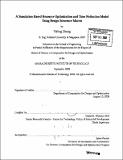| dc.contributor.advisor | Daniel E. Whitney. | en_US |
| dc.contributor.author | Zhang, Yifeng, S.M. Massachusetts Institute of Technology | en_US |
| dc.contributor.other | Massachusetts Institute of Technology. Computation for Design and Optimization Program. | en_US |
| dc.date.accessioned | 2009-04-29T17:20:24Z | |
| dc.date.available | 2009-04-29T17:20:24Z | |
| dc.date.copyright | 2008 | en_US |
| dc.date.issued | 2008 | en_US |
| dc.identifier.uri | http://hdl.handle.net/1721.1/45284 | |
| dc.description | Thesis (S.M.)--Massachusetts Institute of Technology, Computation for Design and Optimization Program, 2008. | en_US |
| dc.description | Includes bibliographical references (p. 87-89). | en_US |
| dc.description.abstract | Project scheduling is an important research and application area in engineering management. Recent research in this area addresses resource constraints as well as stochastic durations. This thesis presents a simulation-based optimization model for solving resource-constrained product development project scheduling problems. The model uses design structure matrix (DSM) to represent the information exchange among various tasks of a project. Instead of a simple binary precedence relationship, DSM is able to quantify the extent of interactions as well. In particular, these interactions are characterized by rework probabilities, rework impacts and learning. As a result, modeling based on DSM allows iterations to take place. This stochastic characteristic is not well addressed in earlier literatures of project scheduling problems. Adding resource factors to DSM simulation is a relatively new topic. We not only model the constraints posed by resource requirements, but also explore the effect of allocating different amount of resources on iterations. Genetic algorithm (GA) is chosen to optimize the model over a weighted sum of a set of heuristics. GA is known for its robustness in solving many types of problems. While the normal branch-and-bound method depends on problem specific information to generate tight bounds, GA requires virtually no information of the search space. Therefore GA makes this simulation- optimization model more general. Results are shown for several fictitious examples, each having some uniqueness in their DSM structure. Managerial insights are derived from the comparison of the GA solutions to these examples with other known solutions. | en_US |
| dc.description.statementofresponsibility | by Yifeng Zhang. | en_US |
| dc.format.extent | 95 p. | en_US |
| dc.language.iso | eng | en_US |
| dc.publisher | Massachusetts Institute of Technology | en_US |
| dc.rights | M.I.T. theses are protected by
copyright. They may be viewed from this source for any purpose, but
reproduction or distribution in any format is prohibited without written
permission. See provided URL for inquiries about permission. | en_US |
| dc.rights.uri | http://dspace.mit.edu/handle/1721.1/7582 | en_US |
| dc.subject | Computation for Design and Optimization Program. | en_US |
| dc.title | A simulation-based resource optimization and time reduction model using design structure matrix | en_US |
| dc.type | Thesis | en_US |
| dc.description.degree | S.M. | en_US |
| dc.contributor.department | Massachusetts Institute of Technology. Computation for Design and Optimization Program | |
| dc.identifier.oclc | 311856378 | en_US |
